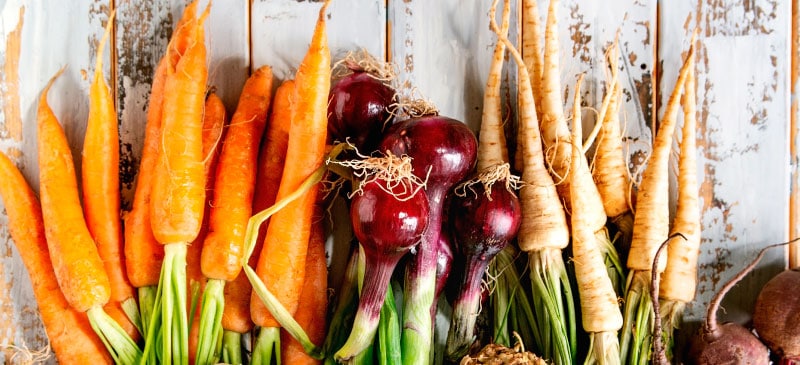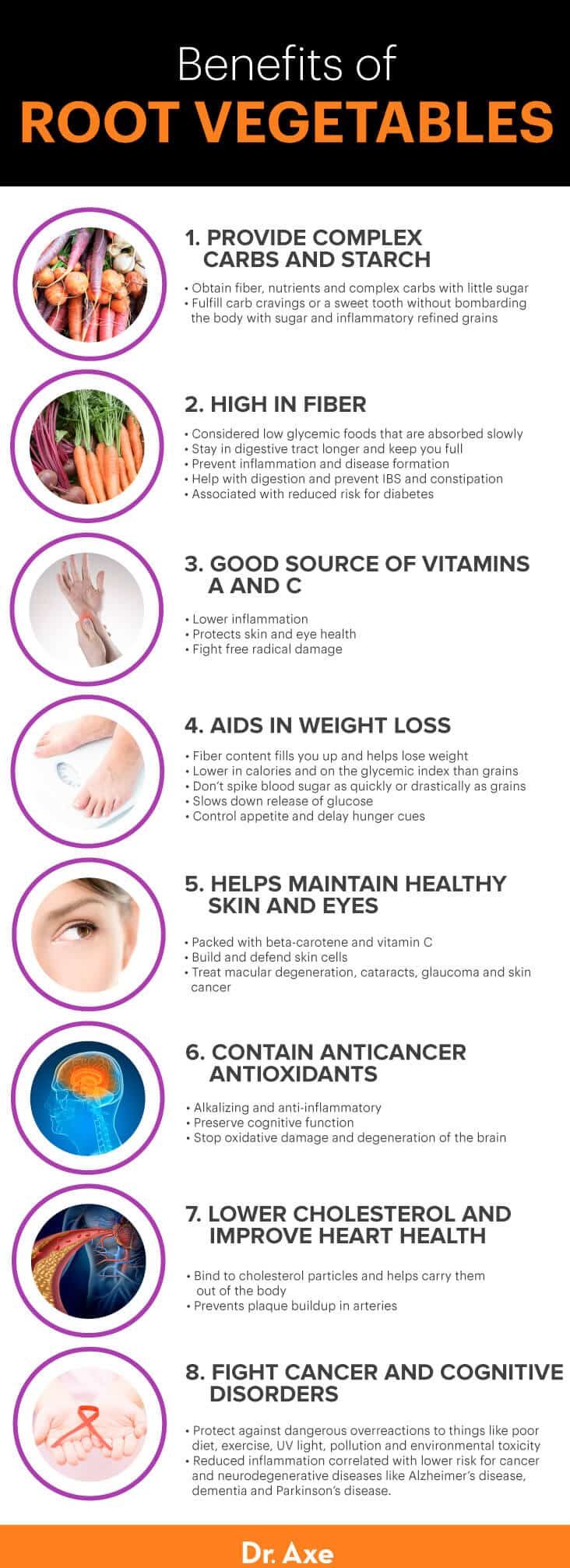
Root vegetables have been a staple in many South American and Asian diets for thousands of years. In fact, records show that certain root veggies like sweet potatoes were important ingredients in folk medicine over 5,000 years ago, and they’ve supported undernourished populations around the world ever since.
Starchy veggies provide vital nutrients like vitamin A, vitamin C, potassium, magnesium and dietary fiber; plus, they’re versatile, inexpensive and easy to prepare. Today, strong evidence suggests root vegetables health benefits may include helping fight cancer, diabetes, obesity as well as inflammatory-based disorders like heart disease and arthritis.
When it comes to replacing grains in your diet (especially refined grains) with root vegetables, there are many benefits. First off, all root vegetables are naturally gluten-free, while many grains — especially the most popular kinds like wheat — are not. Because gluten can cause digestive issues and even autoimmune reactions in some people, root vegetables are a good carbohydrate alternative.
What Are Root Vegetables?
Root vegetables, also called tubers or starchy vegetables, are considered all veggies that grow underground. A root vegetable is defined as “a fleshy enlarged root of a plant used as a vegetable, for example a carrot, rutabaga or beet.” Many are also some of the top fall vegetables.
While technically not all root veggies are tubers (which are defined as geophytes, a botanical term for plants with their growing point beneath the soil), the term “tuber” is commonly used to describe many root veggies. Other types of veggies that we classify as root vegetables are many bulbs, corms and rhizomes. These include veggies like potatoes, sunchokes and yams that are not actually roots but still grow underground.
What is considered a root vegetable? Let’s look at some of the most common questions people have about different types of root vegetables:
- Are potatoes root vegetables? Yes! They are one of the most popular root vegetables in the world.
- Is a sweet potato a root veg? You bet. All types of potatoes (including Yukon, sweet, purple, red, etc.) are considered by most to be root vegetables.
- Is an onion a root vegetable? Yes, most would consider onions, along with garlic, ginger and shallots, to be root veggies because they are bulbs that grow underground. Onions are members of the Allium vegetable family, which includes garlic, onions, leeks, chives, scallions and shallots.
- Is broccoli a root veg? No, broccoli is considered a cruciferous vegetable and a member of the Brassica plant family.
- Is a cucumber a root vegetable? Nope, cucumbers grow above ground and are related to other veggies in the Cucurbits plant family, such as melons, pumpkin, summer squash, etc.
Examples of common types of root vegetables include:
- potatoes
- beets
- parsnips
- carrots
- celeriac
- sweet potatoes
- fennel
- Jerusalem artichokes
- jicama
- yams
- radishes
- turnips
Turmeric, garlic and ginger are also root veggies, even though we think of them more as spices.
Other less common types of root vegetables, at least in the U.S. and many Western countries, include:
- batata
- arrowroot
- boniato
- burdock root
- taro
- daikon
- water chestnuts
- cassava
Root vegetables are truly natural, unadulterated sources of complex carbohydrates, antioxidants and important nutrients. Plus, they tend to be lower in calories, have a lower glycemic index load, and cause fewer digestive or inflammatory issues than many grains do.
Something that makes root veggies interesting is they are “storage organs” for plants, since they hold energy in the form of carbohydrates. Unlike other fresh vegetables, they can stay fresh for months when stored in a cool, dark place, such as a cellar.
While their exact nutrition content differs between various types, most root veggies have about 50–100 calories per ½ cup cooked serving and three or more grams of fiber. This makes them nutrient-dense choices and a preferred way to add starch and sweetness to your diet naturally.
Top 10 Root Veggies
1. Sweet Potatoes/Yams
These are probably most people’s top pick for a tasty root vegetable that has so many uses. Sweet potato benefits include a very high supply of vitamin A (they’re one of the best sources on Earth), potassium, vitamin B5 and vitamin C — in addition to fiber and slow-absorbing starch. They also contain antioxidants/phytonutrients, including chlorogenic acid and anthocyanins.
Even though they’re called “sweet,” they’re actually lower on the glycemic index than regular white potatoes and help stabilize blood sugar better.
Did you know that there are actually more than 200 varieties of yams in existence? What’s the difference between yams and sweet potatoes?
Sweet potatoes are lower in calories and higher in antioxidants, but yams contain higher levels of potassium. They have a similar taste and texture, so both make great choices.
2. Russet or Yukon (White) Potatoes
White potatoes might get a bad rap, but the truth is they do provide plenty of antioxidants and nutrients. In fact, studies have found that potatoes are the largest contributors of vegetable phenolics and antioxidants to the American diet.
Potato nutrition benefits include being a very high source of potassium, which is important for building strong bones and supporting heart health. In fact, potatoes can help lower your risk for dangerously low potassium even more than bananas and sweet potatoes. They have about 20 percent or more of your daily potassium needs in every potato.
White potatoes also contain a good dose of manganese — about 22 percent of your daily value in one potato — which is important for bone and nerve health.
Consider potatoes to be in a separate category from fresh vegetables when it comes to portion, which means about ½ cup to 1.5 cups per day is best. You also want to limit the amount of processed potatoes and sodium you consume.
To preserve their potassium and other nutrients best, eat the skins and only lightly cook them — which means no deep-fried French fries!
3. Carrots
Carrots are one of the most popular veggies worldwide and can be eaten raw, cooked or juiced. Carrots and carrot juice get their signature orange color from antioxidants called carotenoids, which are known for protecting the eyes and skin.
Carrots also supply lycopene, lutein and zeaxanthin antioxidants. In addition to high levels of vitamin A, carrots also provide a good dose of vitamins C, D, E and K — plus magnesium, potassium and calcium.
4. Parsnips
As a member of the same plant family as carrots, parsley and celery, parsnips have a lot of the same benefits of celery, carrots and parsley. They’re a great source of dietary fiber, folate, potassium and vitamin C.
About a ½ cup of cooked parsnips provides three grams of dietary fiber. A high percentage of parsnips’ fiber is soluble, which is linked to a decreased risk of diabetes and high blood cholesterol.
This same size serving also provides about 11 percent of your daily folate, which is important for energy, metabolism, nervous system health, synthesis of DNA and red blood cells formation.
5. Beets
Beet benefits are plentiful thanks to their high antioxidant content, including the unique phytonutrient called betalain. Along with broccoli and peppers, beets have been found to have the highest antioxidant content and oxygen radical absorbance capacity (ORAC) values of 27 vegetables commonly consumed in the United States.
Some evidence shows that beets can enhance your endurance during athletic performance and help you recover from exercise better. Beets naturally contain nitrates, which the body easily uses for muscle recovery, improved circulation, lower inflammation and increased physical performance.
Studies show that supplementing with the type of nitrates found in beets allows athletes to shave minutes off their race times and experience less bodily stress from the exercise. Beets also naturally alkalize and detoxify the body and support hormonal health.
6. Turnips
Turnips are a member of the cruciferous family of vegetables, so they’re related to cancer-fighting veggies like broccoli, collard greens, cabbage, kale and Brussels sprouts. Like other cruciferous foods, turnips and turnip greens contain a type of phytonutrients called indoles that are known to reduce your risk for cancer, especially of the prostate, lungs, stomach and colon.
High in calcium, magnesium and potassium, they’re also a heart-healthy food that supports balanced blood pressure, cholesterol and triglycerides.
7. Rutabaga
Rutabagas are essentially a cross between cabbage and turnips, so they provide many of the same benefits. They’re high in fiber and a great source of vitamin C, with about 47 percent of your recommend daily intake.
Additionally, they’re a high source of zinc, which plays a role in immune health, brain function, mood regulation, metabolism and protection from physiological stress. With a similar taste to turnips and white potatoes, they come out great when roasted and caramelized.
8. Butternut Squash
With a high supply of beta-carotene, butternut squash not only tastes great, but it’s an immune system booster. Generally speaking, the darker the orange hue of vegetables, the higher the content of beta-carotene.
Like other carotenoids, beta-carotene can help turn up communication between cells that destroy cancerous tumor growth and promote lower levels of toxicity. Butternut squash tastes great roasted but can also work in baked goods to take place of sugar or excess butter and dairy.
9. Winter Squash
Just like closely related butternut squash, winter squash provides protective antioxidants, including alpha-carotene, beta-carotene, lutein, zeaxanthin and beta-cryptoxanthin. These are considered essential for eye health and preserving vision into old age since they protect the cornea, macula and retina from damage.
Winter and butternut squashes both have high starch contents, which means they contain polysaccharides found in their cell walls. These polysaccharides include pectins and other starch-related components that have antioxidant, anti-inflammatory and anti-diabetic properties.
10. Jerusalem Artichokes
An extremely good source of fiber, every one-cup serving of cooked Jerusalem artichokes (also called “sunchokes”) provides 10 grams of fiber, in addition to three grams of protein and just 100 calories. They’re also a great source of vitamin A (with about 25 percent of your daily needs in every serving), plus iron and potassium.
In fact, as one of the highest plant sources of iron with 28 percent of your needs, Jerusalem artichokes combat iron deficiency and are a great way to support nerve health, red blood cell formation, anemia prevention and a healthy metabolism.
Related: Horseradish Root Helps Prevent Respiratory Illness, UTIs & Cancer
READ RELATED: How only helpline for desperate victims of prescription pills faces closure – to save just £65,000
Health Benefits
1. Provide Complex Carbs and Starch
Roots and tubers are considered important sources of energy as starch. While the average person consumes way more carbohydrates than may actually be beneficial, many people still feel and operate their best when they consume a certain moderate level of carbs from natural sources.
Starchy root vegetables are a great way to obtain fiber and nutrients along with some complex carbs and relatively little sugar. This especially applies if you’re an athlete, child, someone looking to gain weight or if you exercise a lot. Starchy veggies also help fulfill “carb cravings” or a sweet tooth without bombarding your body with sugar and inflammatory refined grains.
What about if you follow a low-carb diet? What root vegetables are low-carb?
Root veggies are generally higher in carbs than other veggies, such as leafy greens or cruciferous veggies. Although they contain some natural sugars in the form of starch, root veggies are high in fiber and therefore still mostly considered foods that are absorbed relatively slowly. If you do choose to include root veggies in your low-carb diet, some of the best low-carb root vegetable options are parsnips, carrots, beets, rutabaga and celeriac.
2. High in Fiber
High-fiber foods stay in your digestive tract longer, and in the process, they keep you full. Part of their fiber also holds valuable polysaccharides, which are found in plant foods and shown to exhibit multiple biological activities, including anti-carcinogenic, anticoagulant, immune-stimulating and antioxidant effects.
A high-fiber diet not only helps prevent inflammation and disease formation, but it also works wonders for helping with digestion and preventing IBS or naturally relieving constipation.
While many grains, especially refined grains and flour products that are low in fiber, are considered “fast carbs” that spike blood sugar abruptly, root veggies are known for being “slower-burning carbs.” According to many large studies, like one that appeared in the European Journal of Clinical Nutrition in 2012, higher root vegetable intake is even associated with a reduced risk for diabetes.
3. Good Source of Vitamins A and C
Root vegetables are some of the best sources of carotenoid antioxidants and vitamin A and C in the world. Beta-carotene, a precursor to active vitamin A, is found in high quantities in sweet potatoes, carrots, beets and other root vegetables and is crucial for lowering inflammation, protecting skin and eye health and fighting free radical damage.
Both vitamin A and vitamin C foods benefit the immune system by lowering inflammation that is at the root of most chronic diseases, like cancer and heart disease.
There are two types of vitamin A that we acquire from foods. The type found in root veggies and other colorful fruits and vegetables is called “pro vitamin A,” a type of carotenoid antioxidant that is converted to retinol by the body after the food is ingested.
Beta-carotene, a type of carotenoid found primarily in plants, needs to first be converted to active vitamin A in order to be utilized by the body.
4. Can Help You Lose Weight
One of the secrets to losing weight fast and easily is to up your fiber intake. While you might be hesitant to include more root vegetables in your diet because they’re starchy and higher in carbs than other veggies, their fiber can actually help you lose weight because it fills you up.
Compared to grains, most root vegetables are lower in calories and lower on the glycemic index, which means they won’t spike your blood sugar as quickly or drastically.
The fiber in starchy veggies slows down the release of glucose (sugar), which is important for energy and insulin balance. Starchy vegetables eaten with a balanced meal can help control appetite and delay hunger cues, which is important for weight management, fighting cravings and reducing the risk of insulin resistance.
5. Help Maintain Healthy Skin and Eyes
If you want healthy, glowing skin, consider eating more root vegetables. Many are packed with beta-carotene and vitamin C that help build and defend skin cells. A high content of beta-carotene is used to convert vitamin A in your body that triggers DNA to produce new skin cells.
Beta-carotene also helps reverse free radical damage, which can lead to age-related eye disorders, sun spots, wrinkles, UV damage and potentially skin cancer. In fact, a diet high in vitamin A and vitamin C can act like a natural treatment for macular degeneration, cataracts, glaucoma and skin cancer.
6. Contain Anti-Cancer Antioxidants
You may not think of things like potatoes and turnips as high-antioxidant foods, but they definitely are. Many root vegetables are great sources of antioxidant flavonoids, which are actually responsible for some of their deep colors — like the orange of sweet potatoes or purple of beets.
Considered to be alkalizing and anti-inflammatory foods, nearly all root veggies supply carotenoid antioxidants like lutein and zeaxanthin, but that’s not all. Purple sweet potatoes contain the antioxidant anthocyanin, which has been shown to preserve cognitive function and stop oxidative damage and degeneration of the brain.
Meanwhile, beets contain betalains, which are highly anti-inflammatory.
7. Help Lower Cholesterol and Improve Heart Health
A high-fiber diet filled with whole foods containing both soluble and insoluble fibers is key for heart health and balanced cholesterol and triglyceride levels. Eating fiber is a way to naturally lower cholesterol because it binds to cholesterol particles and helps carry them out of the body. This means cholesterol is less able to form sticky plaque buildup in arteries, which can raise the risk of heart disease, heart attacks or strokes.
Many root vegetables also are potassium-rich foods, which is beneficial for healthy blood pressure, nerve signaling and fluid balance.
A 2009 study published in the Journal of Diabetes Science Technology found that a Paleolithic-type diet improved both cardiovascular risk factors and glycemic control when compared to a standard diet or even “diabetes diet.” While the Paleo diet included root vegetables, it did not include any type of grains.
The results showed that the group following the Paleolithic diet for three months experienced statistically significant lower mean values of hemoglobin A1c, triglycerides, diastolic blood pressure, weight, body mass index and waist circumference.
8. Help Fight Cancer and Cognitive Disorders
Vitamin A found in many root vegetables has been correlated with better brain function, cognitive health and cancer protection. Inflammation and oxidative stress are two primary causes of cancer formation, but vitamin A, vitamin C and other antioxidants can help boost cellular health and lower the body’s inflammatory responses.
This means better protection against a dangerous overreaction to things like a poor diet, exercise, UV light, pollution and environmental toxicity. Reduced levels of inflammation are also correlated with a lower risk for neurodegenerative diseases, like Alzheimer’s disease, dementia and Parkinson’s disease.
Where to Find and How to Use
Look for root vegetables at your local farmers market, grocery stores or health food stores. Most root veggies should appear smooth, be firm to touch, and be completely free of soft or mushy spots. Ideally, the skin will appear free of deep or dark blemishes, but a bit of dirt is nothing to worry about, especially if you purchase organic veggies — which is recommended.
The best way to store root vegetables is to keep them somewhere cool, which will help keep them fresh for weeks and even months. For example, some people like to keep potatoes, sweet potatoes and onions in a cool or room-temperature dark cupboard in their kitchens or even in a cellar or cool basement. Most other root vegetables are best kept in the refrigerator.
Cooking Root Vegetables
When it comes to cooking root vegetables, you have several options: They can be roasted/baked, boiled, slow-cooked, grilled or cooked in an instant pot. Most chefs recommend cooking them in a very hot oven around 425 degrees Fahrenheit.
You can peel the vegetables first if you prefer, and then cut them into 1- to 2-inch chunks. Toss them with some quality butter or coconut or avocado oil and a sprinkling of salt and pepper, and bake for between 20 to 45 minutes depending on the kind and size.
To grill root vegetables, halve or thickly slice them, and grill about 10 minutes per side. You can also bring a big pot of water to a boil, add salt and cook your vegetables until they are tender, for about 20 minutes.
How Much Should You Include in Your Diet?
This depends a lot on your individual needs, body type, metabolism and level of physical activity. For example, people who exercise often can get away with eating more carbohydrates in general than people who are more sedentary.
Aim for one to two small servings of various root vegetables a day, and see how your body responds. Each serving should be about ½ cup cooked.
As part of an otherwise balanced diet with healthy amounts of quality protein, fat and non-starchy veggies, this amount shouldn’t cause weight gain for most people and will provide a good course of nutrients.
Recipes
Some of the most popular ways to use root vegetables in recipes include making:
- oven-roasted root vegetables like potatoes with rosemary
- baked root vegetables like sweet potatoes with butter and cinnamon
- roasted root vegetables soups made with rutabaga or celeriac
- slow cooker root vegetables, such as beets, yams, etc.
Here are some healthy root vegetable recipes to try at home:
Risks and Side Effects
Are root vegetables ever bad for you? While they offer a load of benefits, portion control is still important when it comes to root vegetables since they are high in starch, especially if you’re struggling to reach and maintain a healthy weight, stabilize blood sugar, reduce overall sugar in your diet or have diabetes.
Remember that while root veggies can definitely be a part of a balanced diet, it’s important not to reduce their benefits by preparing them in unhealthy ways, such as slathered in lots of butter, cheese or processed oil.
Final Thoughts
- Root vegetables, also called tubers or starchy vegetables, are considered all veggies that grow underground. A root vegetable is defined as “a fleshy enlarged root of a plant used as a vegetable.”
- Common types of root vegetables include potatoes, beets, parsnips, carrots, celeriac, sweet potatoes, Jerusalem artichokes, jicama, yams and turnips.
- Benefits of eating root veggies include being high in fiber, essential nutrients and starch/complex carbs; weight management; and having a lack of gluten.
- Root vegetables also provide important antioxidants, minerals like potassium and magnesium, vitamin C, and vitamin A. They may be able to help reduce the risk for health problems like skin cancer, vision loss, cognitive decline and heart disease.
Source:







